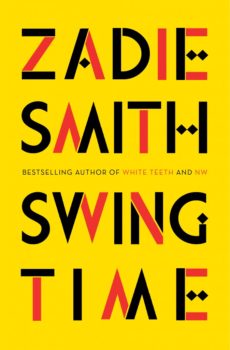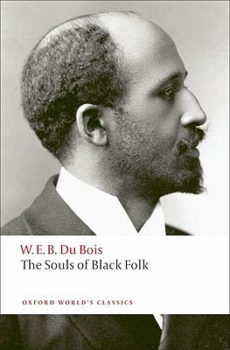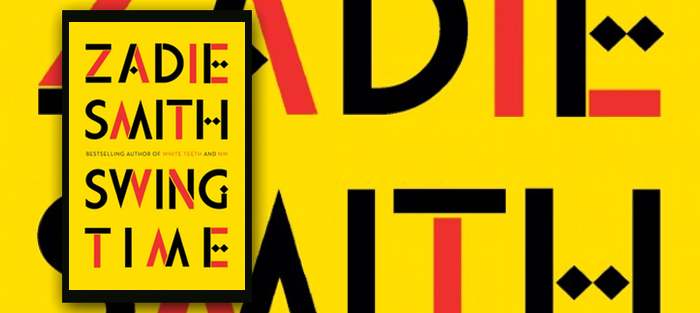The novelist E.M. Forster, one of Zadie Smith’s literary heroes, described the Greek poet C.P. Cavafy as having the “strength of the recluse, who, though not afraid of the world, always stands at a slight angle to it.” The same could be said of Smith and politics. She is not afraid of the political, but her work is always pitched at a slight angle to it. In a recent interview in Slate, she commented that she does not have a “political intelligence” (I admit I find this hard to believe), that her “first concern is people,” but that “sometimes people’s intimate lives reflect the political world.” She may not deliberately impose the political on her work, but the political certainly emerges from it. What often transpires is a complicated intersection of conflicting ideas, ideals, and positions. It’s art, after all, not propaganda.
Intentionally political or not, Zadie Smith is without question one of our most astute cultural critics, and Swing Time (The Penguin Press), like her previous four novels, showcases her keen ability to examine a character’s psychological landscape while interrogating a cultural moment. Of Zadie Smith’s previous novel, NW (The Penguin Press, 2012), I wrote in a review for this publication: “Through repetition and refraction, each point of view brings new and surprising insight into events.” In Swing Time, new insight comes not from the way various characters’ perspectives shape the story, but from the narrator’s storytelling herself, a fragmented, shadow-self living in various fragmented realities, none to which she feels she fully belongs.
It is perhaps due to this particular narrative stance that Swing Time is Smith’s most melancholic work to date. Though the jacket copy calls it “exuberant,” to me it felt careful, wistful, resigned—punctuated by periods of “kinetic joy” that come, most often, through dance. In fact, I was puzzled by the jacket copy until I considered the other meanings of “exuberant”: not marked by unrestrained joy but by productive abundance, luxuriant growth. Swing Time is a novel that pours out, unrestrained yet delicately woven, like memory. Memory is often infused with joy, but also with shame, and the narrator feels the latter deeply, along with a desperate need to understand both where she has come from and where that might lead her, and how, most important, the two things are related.
She, the narrator, remains unnamed, simply an “I” who tells the story of her childhood in North West London and her friendship with Tracey (of whom she writes: “Our shade of brown was exactly the same— as if one piece of tan material had been cut to make us both”), and then of her job as an assistant to the mononymous Aimee, a white, global pop star whose project becomes opening a girls’ academy in a village in an also unnamed (though identifiable by geography, ethnic groups, and languages as Gambia) West African country. These two relationships—with Tracey and with Aimee—center the novel, and Tracey and Aimee act as doubles to which the narrator is a shadow.
 If NW was built around the characters’ resistance to adulthood, Swing Time is the narrator’s own search for it. Whereas NW was concerned with time as an adversary, Swing Time examines time as both a political and philosophical construct, a way of shaping reality. Our experience of time, after all, often has nothing to do with increments on the clock. Swing Time’s time often collapses, or feels multidimensional. Of her initial encounter with Tracey, the narrator remarks: “If all the Saturdays of 1982 can be thought of as one day, I met Tracey at ten a.m. on that Saturday, walking through the sandy gravel of a churchyard, each holding our mother’s hand.”
If NW was built around the characters’ resistance to adulthood, Swing Time is the narrator’s own search for it. Whereas NW was concerned with time as an adversary, Swing Time examines time as both a political and philosophical construct, a way of shaping reality. Our experience of time, after all, often has nothing to do with increments on the clock. Swing Time’s time often collapses, or feels multidimensional. Of her initial encounter with Tracey, the narrator remarks: “If all the Saturdays of 1982 can be thought of as one day, I met Tracey at ten a.m. on that Saturday, walking through the sandy gravel of a churchyard, each holding our mother’s hand.”
In The Art of Time in Fiction, Joan Silber writes: “A story is already over before we hear it. That’s how the storyteller knows what it means.” In Swing Time, the narrator’s story is indeed “over” when it begins, a move that at first feels deceptively simple: “It was the first day of my humiliation,” starts the prologue, and the novel that follows aims to tell the story of how the narrator arrived at that point. A framing device.
But simple only at first glance. Time winds around itself in this novel; it becomes the novel’s subject. The structure becomes a frame with a double helix within it, and ideas, images, motifs, and shadows of the past reappear again in the present. The sections do not always move forward chronologically but instead wind around one another. Moments are returned to and recollected, with new information weaving in with what we have been told before. Swing Time is about multiple temporal realities and their relation to identity, memory, desire, freedom, and independence, and the way these realities position themselves to, or shadow, one another. The notion of time and reality as distinct closed loops we move through may have something to do with the fact that the two storylines, though they veer awfully close to each other, never quite meet the way we might expect, in the way that this pendulum-swing structure might imply.
In the opening pages, the narrator notes her lack of knowledge about social realities outside her immediate experience: what shoes to wear for modern dance class; and what was modern dance class; and when you went to a film for a classmates’ birthday party, who paid for the tickets? “There was no one you could ask,” she notes. Her own reality was confined to her immediate environs, marked by class and race: the public housing low-rise apartment building in which she lived and the less-nice high rise “of poor reputation” where Tracey lived. “From my balcony I could see into her estate and vice versa,” she notes. A sort of doubling, or mirroring. Whereas Tracey’s mother is white and her father black, the narrator’s mother is black and her father white, a fact that Tracey comments on as having it wrong.
The narrator is enamored of dancers—old films with Fred Astaire and Ginger Rogers— but she herself has flat feet, and a future in ballet is out of the question. Tracey, on the other hand, “knew the right time to do everything” (a skill that will return again and again, sometimes in the narrator’s favor, but usually not), and possesses a deftness the narrator does not—both on the dance floor and off. Tracey’s bedroom, with its Barbie sportscar bed, the mess of toys, “was a revelation,” she notes, and “overturned everything I had understood about our shared situation.” The narrator’s mother points out that Tracey is only being raised for the present moment, whereas the narrator for something else. “You know where you came from and where you’re going,” her mother says.
Though it’s clear, as the novel progresses, that the narrator does not.
Tracey helps define her reality. Of their earlier years in school together, the narrator notes: “It took Tracey moving to my classroom for me to understand what my classroom really was.” And then later, when she attends a new school without Tracey, she was “a body without a distinct outline,” Tracey continuing to define her reality even in her absence. As they grow older, the narrator is unable to imagine Tracey’s life as going on without her: Running into her was “a form of existential shock, like seeing someone from a storybook in real life.”
 Their immediate realities begin to fragment and split, and the contrast of life in their own apartments, beyond simply physical environment, is a precursor to much greater schisms between them. Time collapses, and one evening when they’re older they’re walking down the street smoking a joint, “remembering the times [they’d] performed this same action down the same road aged twenty, fifteen, thirteen, twelve.” The narrator tells Tracey about her first job, and when they get back to the narrator’s father’s house, Tracey claims to have seen something that permanently splits their shared timeline in two: “into her reality and mine, or her fiction—as far as I was concerned—and my fact.”
Their immediate realities begin to fragment and split, and the contrast of life in their own apartments, beyond simply physical environment, is a precursor to much greater schisms between them. Time collapses, and one evening when they’re older they’re walking down the street smoking a joint, “remembering the times [they’d] performed this same action down the same road aged twenty, fifteen, thirteen, twelve.” The narrator tells Tracey about her first job, and when they get back to the narrator’s father’s house, Tracey claims to have seen something that permanently splits their shared timeline in two: “into her reality and mine, or her fiction—as far as I was concerned—and my fact.”
But though this is a novel about looking back into the past to make sense of the present, it’s also about the elements of our past that we confine to the shadows. The dancing Fred Astaire in Swing Time looms so large for the narrator, yet it’s not until after her humiliation that she watches the clip again and is horrified to notice Astaire was in blackface. She’d “managed to block the childhood image from [her] memory: the rolling eyes, the white gloves, the Bojangles grin.” Because now, of course, that is all she sees. She is sickened by it, a stark moment that reminded me of the poet Kevin Young’s meditations on blackface: “Sinking Feeling: blackfaced person always occupies a bigger public stage than a black one.”
She soon begins to develop a hyper-real sense of multiple realities, all the more prominent as she travels with Aimee to West Africa to find a site for the academy for girls. She looks for herself, and her mother—a woman who believed that “the definitions that really mattered were culture and color—in the faces she encounters there, and is surprised much later, after she finally dances at a big celebration in the village, when Hawa, the young Muslim woman who hosts them, says: “Even though you are a white girl, you dance like you are a black!”
Her mixed identity is not only racial but cultural—her mother is Jamaican and her father British—but her own identity confusion often stems from the reactions of others, particularly regarding what she feels is an unconvincing connection between herself and her white father. “And yet, in our family…we always batted away what we considered to be the banal and prurient curiosity of strangers—‘But won’t she grow up confused?’ ‘How will she choose between your cultures?’— to the point that sometimes I felt the whole purpose of my childhood was to demonstrate to the less enlightened that I was not confused and had no trouble choosing.”
But despite the narrator continuing to seek out her identity—not only regarding race but also her own adult presence in the world—she is treated like a child in the village: “Yes, great care was taken at all times to protect me from reality. They’d met people like me before. They knew how little reality we can take.” Still, that doesn’t stop her from asking many questions, such as when the narrator observes the ritualistic tradition of the kankurang, a “dancer who comes for the boys,” initiating them into their culture, leading “the young through their difficult middle passage, from childhood to adolescence.” She wonders: “Who comes for the girls? If not the kankurang, who? Their mothers? Their grandmothers? A friend?” This sentiment echoes her anxiety of not being able to translate her new cultural reality.
But perhaps she also means: Who will come for me?
Regardless of whether her mother comes for her, she’s ever-present, whether the narrator is in New York or London or Gambia. When the narrator is a child, her mother tells her about the sankofa, a bird that “looks backwards at the past, and it learns from what’s gone before,” and this concept drives the novel forward. (And back. When Aimee later adopts a girl from the village, with virtually no complications, she names her Sankofa—a beautiful irony from a woman who seems to only forge ahead, unaware of what she leaves in her wake, and what she destroys).
The narrator’s mother, an aspiring intellectual, is always studying, enriching a mind that was left unenriched, wanting to “claw some space in this world for herself,” which she finally does, but only at the expense of her marriage. “More than she knew or cared to know, she was someone who lived in her own dreamscape, who presumed that everyone around her was at all times feeling exactly as she was.” The narrator’s father—unambitious, white—is a kind, good man, but for the narrator’s mother he was not enough. But “How he loved her!” the narrator muses, recognizing that to her mother entrapment and love were synonymous, a notion she might internalize, though she manages to find a different kind of entrapment of her own. In a novel set in West Africa, whose narrator wanders through the slave forts, who calls her adolescence a “middle passage,” and who is subservient to a white woman, it’s difficult not to confront issues of appropriation, enslavement, and ownership. “You’re addicted to that phone,” her mother says. “You do know that?”
She replies: “It’s work, Mum. This is how people work now.”
“You mean: like slaves?”
When the narrator protests, claims that she has a life, her mother considers this a moment before she responds: “No, that’s not right— you don’t have a life. She has a life. She has her men and her children and her career— she has the life. We read about it in the papers. You service her life.”
Originally from Bendingo, Australia, pop-star Aimee “found her own story universally applicable.” The narrator asks: “What could [Aimee] know about the waves of time that simply come at a person, one after the other? What could she know about life as the temporary, always partial survival of the process?” This is one of the narrator’s most stirring statements, reminiscent of W. E. B. Du Bois’s ideas of double consciousness. Aimee “believed in her own good timing, in timing itself, as a mystical force, a form of fate, operating at the global and cosmic level as much as at the personal.” (Tracey, of course, with her own perfect sense of timing, does not fare as well, and though she is talented, and working, her dance career does not go too far.)
 Aimee’s arrogance stems from the worst kind of white privilege (and privilege, after all, rests partly in the inability to recognize it as such): the assumption that because she came from nothing that anyone could also have her experience, that she “accepts everything that has happened to her as her destiny, no more surprised or alienated to be who she is than … Cleopatra was to be Cleopatra.”
Aimee’s arrogance stems from the worst kind of white privilege (and privilege, after all, rests partly in the inability to recognize it as such): the assumption that because she came from nothing that anyone could also have her experience, that she “accepts everything that has happened to her as her destiny, no more surprised or alienated to be who she is than … Cleopatra was to be Cleopatra.”
“There were things she wanted to be but she couldn’t, not then—she was trapped,” the narrator remarks to Aimee about her own mother. “She had to fight for any time for herself.”
Aimee’s response is nearly comical in its lack of self-awareness: “Well, I’m a single mom. And I can assure you that my baby doesn’t stop me doing a damn thing. He’s like my fucking inspiration right now if you really want to know. It’s a balance, for sure, but you’ve just got to want it enough.”
The narrator then thinks of Aimee’s Jamaican nanny, Estelle, and muses: “That there might be any practical divergence between my mother’s situation and her own did not seem to occur to Aimee, and this was one of my earliest lessons in her way of viewing the differences between people, which were never structural or economic but always essentially differences of personality.”
Granted, Aimee is a superstar, but her characterization feels pitch perfect, emblematic of elements in our culture that have nothing to do with international stardom. Particularly in the curated, stripped down world of social media, where a certain type of privilege seems magnified and its touting encouraged, the disparity between postings of seaside vacations, newly remodeled kitchens, and farm-to-table meals, and the more sharp political realities and significant global events, feels more than disconcerting.
Aimee takes what she wants, and what she feels she needs, including Lamin, the young teacher trainee plucked from his West African country to be her lover, her dancer, to have a shot at a different life (“Jesus Christ,” the narrator exclaims. “Is she going to marry him? Is she going to adopt him?”). And though Aimee means well, her altruism still feels self-centered, self-aggrandizing, and in a post-Trump-election world I’m all too aware of the way checking one’s white privilege is often done in well-meaning but insensitive ways: wearing a safety pin to show solidarity, for instance, or crying and asking to hug a person of color. Such actions, though with good intentions, focus on the emotional experience—or the social reception—of the doer.
Though unlike a safety pin or a public outburst of emotion, Aimee’s school does make a structural difference in the immediate lives of the girls it’s meant to serve, though its ripple effect throughout the rest of the village is less than ideal. But this, of course, is not Aimee’s problem. Aimee has no interest in after, leaving her staff to take care of the school while she moves on to another project. She constructs her own present reality and demands that others follow along. “I thought about what it might feel like to live in a world where facts shift or disappear, depending on your mood,” the narrator muses. Aimee’s staff allows her freedom from complication: they “were being paid . . . to keep life uncomplicated— for her. We waded through the tangled weeds so she might float over the surface.”
This is not to say that the narrator is not without her own blindnesses: though Aimee views Africa in a way Chimamanda Ngozi Adichie has called “the danger of a single story,” the narrator is also not immune to such simple-minded thinking. When she asks Fern, a colleague from Brazil, what a neighboring country is like, but really simply meaning “Africa,”—this on the plane, before she had arrived—he turns to her, “red-faced, and demands: ‘If we were flying to Europe and you wanted to know what France was like, would it help if I described Germany?”
Although the narrator may at times seem myopic, the novel itself has great scope. So many issues are woven into this novel, in fact, that it’s understandable that some of them are not interrogated as deeply as they might be. Though the novel relies on other characters (her mother and Tracey, or the men she briefly dates, as well as people she meets in Gambia—Fern, Lamin, and Hawa, among others) to reorient or recontextualize some of the narrator’s more naïve musings, the limits of her own perspective might feel frustrating to readers craving a more in-depth interrogation regarding the myriad issues the novel raises.
And she may realize this as well. One evening, when she’s guiltily skipped one of Aimee’s performances, she begins searching online, realizing she “could reconstruct—140 characters at a time, image by image, blog post by blog post—the experience of having been there” to the point that she was perhaps more there than had she been limited by that actual space and immediate temporality. “I was far more there than any of the people who had actually been there, they were restricted to one location and one perspective—to one stream of time [emphasis mine]—whereas I was everywhere in that room at all moments, viewing the things from all angles, in a mighty act of collation.”
The narrator knows Aimee at such an intimate level that she becomes an extension of Aimee, and to watch her perform was too strange: “the artificial performance of someone I had come to know too well at a deeper, granular level.” Here, instead, she removes herself from this linkage entirely, allowing herself a real-time omniscience. She stays online for hours, but after she’s seen the responses across countries and continents, she’s left facing an online comment made by none other than Tracey, who posts a photo that zeroes in on the adinkra fabric the dancers were wearing, “a rich cerulean blue printed with a pattern of black triangles, and in each triangle there was an eye. Tracey had taken this image, expanded it many times, cropped it, so only the triangle and the eye were still visible, and underneath this image she asked the question: LOOK FAMILIAR?” The narrator does not comment, neither online nor to the reader, but it alludes to their ten-year-old selves, buying Aimee’s new single and staring intently at the cover, confused by this image. Tracey could be addressing the community of Aimee’s fans, or she could be addressing the narrator herself, but either way, it’s her presence in the narrator’s self-imposed appropriation of time that feels resonant. Again, the narrator is forced to face what she cannot: who she is, and who will come for her.
Is time a sort of memorialization? To be aware of time is to be aware of our own role in our individual and collective realities, and how those realities—those moments in time—differ across race and nation and class. When she first arrives in the village, the narrator experiences “an unexpected but not unpleasant sense of stillness, of being outside of time: it reminded me somehow of childhood.” She is “completely unreachable, for the first time in years.”
In our current cultural moment, where our experience of collective time feels both urgent and detached, this commentary (along with the way the narrator, near the end of her story, is also outside time, having been offline for 72 hours) is telling. And it echoes a film she watched in college, whose narrator states: “A hundred years ago mankind was confronted with a question of space, but that the problem of the twentieth century was the simultaneous existence of different notions of time.”
About their departures from the village back to their respective cities, the narrator notes the way it all seemed unreal, that something in them, or their homes, had changed. But this new perception of reality lasts only for a while before their old habits return. “We left taps running,” she notes, “abandoned plastic bottles after a few sips, bought a single pair of jeans for the same sum as a trainee teacher’s yearly wage.” And: “If London was unreal, if New York was unreal, they were powerful stage-shows: as soon as we were back inside them they not only seemed real but the only possible reality, and decisions made about the villages from these locations always appeared to have a certain plausibility while we were making them, and only later, when one or other of us arrived back here, and crossed this river, did the potential absurdity of whatever it was become clear.”
So realities, of course, are plural, and Smith explores the ability—or refusal—to not only acknowledge other people’s independent realities but to understand them as different from one’s own: “When I was her age I wanted freedom!” the narrator exclaims of Hawa, whose radical change as a result of her upcoming marriage has surprised them all.
Her partner in conversation, Fern, says: “Sometimes I wonder if people don’t want freedom as much as they want meaning.” It is surely not an original idea, but in the context of this novel, and in the context of our larger global political climate, it is nevertheless a significant one. Fern’s comment does two things: points out the narrator’s Western perspective and also forces us to consider the various manifestations of freedom, both as explored in the novel and beyond.
In this moment, although the narrator still wants to argue with Fern, she instead hands him one of her headphones. Together they listen to podcasts, to “accounts of these American lives, the minor dramas and satisfactions, their pleasures and irritations and tragicomic epiphanies.” And though the show is unnamed, I can almost hear Ira Glass’s distinct voice rising from the page.
It is a sweet moment, but not without a more troubling subtext. The two of them, at the moment, escape into another more comfortable reality, and these are the moments where Smith is at her best differentiating the realizations that might feel slightly naïve to a more sophisticated reader while also understanding the limits of her chosen perspective. I could not help but think of James Baldwin, who wrote to his nephew on the one hundredth anniversary of the Emancipation Proclamation: “You know and I know that the country is celebrating one hundred years of freedom one hundred years too early.” Freedom and time are relative, and inextricably linked.
The narrator, after all, had spent the last decade subservient to someone else. “A truth was being revealed to me: that I had always tried to attach myself to the light of other people, that I had never had any light of my own. I experienced myself as a kind of shadow.”
In fact, the narrator seems almost desire-less, existing only to serve Aimee. Audre Lorde, in her essay “Uses of the Erotic: The Erotic as Power,” writes:
The fear of our desires keeps them suspect and indiscriminately powerful, for to suppress any truth is to give it strength beyond endurance. The fear that we cannot grow beyond whatever distortions we may find within ourselves keeps us docile and loyal and obedient, externally defined, and leads us to accept many facets of our oppression as women.
The narrator’s desire for Lamin, who “belongs,” in a crude sense, to Aimee, is finally acted upon in a parallel reality. Their first sexual encounter she describes as “so separated from my daytime life that it felt to me that they had happened to someone else, a shadow body who pursued separate aims and could not be forced into the light.”
This action is tied to the opening section’s “humiliation,” but it may also result in her freedom as well. It has left the narrator untethered from Aimee but also without a framework to push up against. “[Aimee] was really the person we were aiming at with all our loveless fucking, as much a part of the process as if she were in the room.” It was easy to act when she and Lamin were both in Aimee’s shadow, their boundaries defined by their relation to her. In fact, everything in the narrator’s life, over the past decade, had been defined in relation to her—her twenties and early thirties all belonged to Aimee. Untethered from Aimee by their own actions, they are both lost, no longer interested in each other but yoked together by scandal. And, quietly, without informing the other, they plan their respective escapes.
And so the narrator, now aimless, must return to her past self to make sense of who she will become. She “had no coordinates.” Released, as it were, in time and space. It’s fitting that she comes full circle, ending up in her mother’s apartment: “I opened my laptop and returned to . . . searching for myself, reading of myself, and seeking Tracey, too, below the line.”
Her mother, who has by now had a productive career in politics, has also grown ill, and the last time the narrator sees her, she’s talking of Tracey’s children. “[A]lthough in speaking of them she moved freely between their reality, as she imagined it, the history of our own little family, and a deeper history,” the narrator notes. Her mother also begins to conflate herself and Tracey and the narrator, as if they are all the same woman, and she confuses the present and the past: “She works too hard,” her mother says, “and the children don’t see her, and now they want to take my children away, but your father was very good, very good, and often I think: was I a good mother? … But I was just a student, I am studying, because you have to learn to survive, and I was a mother and I have to learn, because you knew that any one of us they caught reading or writing faced jail or a whipping or worse…..and in that way we were taken out of our time and place.”
The narrator muses of her mother:
Of all the futures I had imagined for her in these streets somehow the present reality seemed the most improbable. When I was a child she had been immortal. I couldn’t imagine her leaving this world without ripping its fabric. Instead, this quiet street, these gingko trees shedding their golden leaves.
After this visit, the narrator decides to see Tracey again. Perhaps she’s wondering, now that she’s freed, how she might “carve out some space for herself” as her mother had done; perhaps she is coming for Tracey and her children the way she hoped someone would come for her. What she finds is their child-selves, their mothers, shadows of themselves. The end image is beautifully ambiguous, satisfying, and perhaps another echo of all those Saturdays of 1982. And like so many of the charged moments of this novel, it involves a balcony, a site of drama and dances and sex, performances of motherhood and secrets, a wonderfully significant setting in a novel that so artfully blurs the boundaries between public and private spaces. You could burn someone’s house down, to paraphrase the narrator, from the comfort of your own bed.
In his short, smart book, The Art of Perspective, Christopher Castellani writes:
If it’s a given that stories exert power . . . then who tells the story occupies the most powerful position of all. . . . . Who tells a story claims responsibility for it. In devising and drafting a narrative strategy, an author makes all sorts of craft decisions that influence how the work will be read and enjoyed, but these technical decisions become deeply social and political when she gives over the narrative reins to someone on the margins, or who might otherwise be despised, or who has been invisible.
The narrator has spent most of her life in other people’s shadows, but through her storytelling asserts an identity that’s no longer tethered to another, one released only by disgrace. Narration, for her, is an assertion of autonomy, a kind of self-care—and by this I do not mean spa dates with friends but in Audre Lorde’s way, self-preservation as a kind of political warfare, or at least a statement. She notes that “it’s a good friend who wakes a friend from her dream,” and though she is talking about waking Aimee from her dream, the book may suggest that others have done this for the narrator as well. There’s a bleakness to the ending, but an openness too, not without beauty or expectation. Perhaps all these fragmented selves will finally be allowed to merge, maintaining all the fragments but allowing for the existence of—to quote Du Bois—“a better, truer self.”
Work Cited
- Adichie, Chimamanda Ngozi. “The Danger of a Single Story.” TED Talk. July 2009.
- Baldwin, James. Originally appeared in The Progressive, December 1962, then adapted in The Fire Next Time. New York: Dell, 1962.
- Castellani, Christopher. The Art of Perspective: Who Tells the Story. Minneapolis: Graywolf, 2016.
- Du Bois, W. E. B. The Souls of Black Folk. New York: Dover, 1903. 1994 edition.
- Forster, E. M. “The Poetry of C. P. Cavafy.” Pharos and Pharillon, New York: Knopf, 1923.
- Lorde, Audre. “Uses of the Erotic: The Erotic as Power.” In Sister Outsider: Essays and Speeches. Berkeley: Crossing Press, 1984, 2007.
- Silber, Joan. The Art of Time in Fiction. Minneapolis: Graywolf, 2009.
- Young, Kevin. “Blacker Than Thou.” In The Fire This Time: A New Generation Speaks about Race. Edited by Jesmyn Ward. New York: Scribner, 2016.







